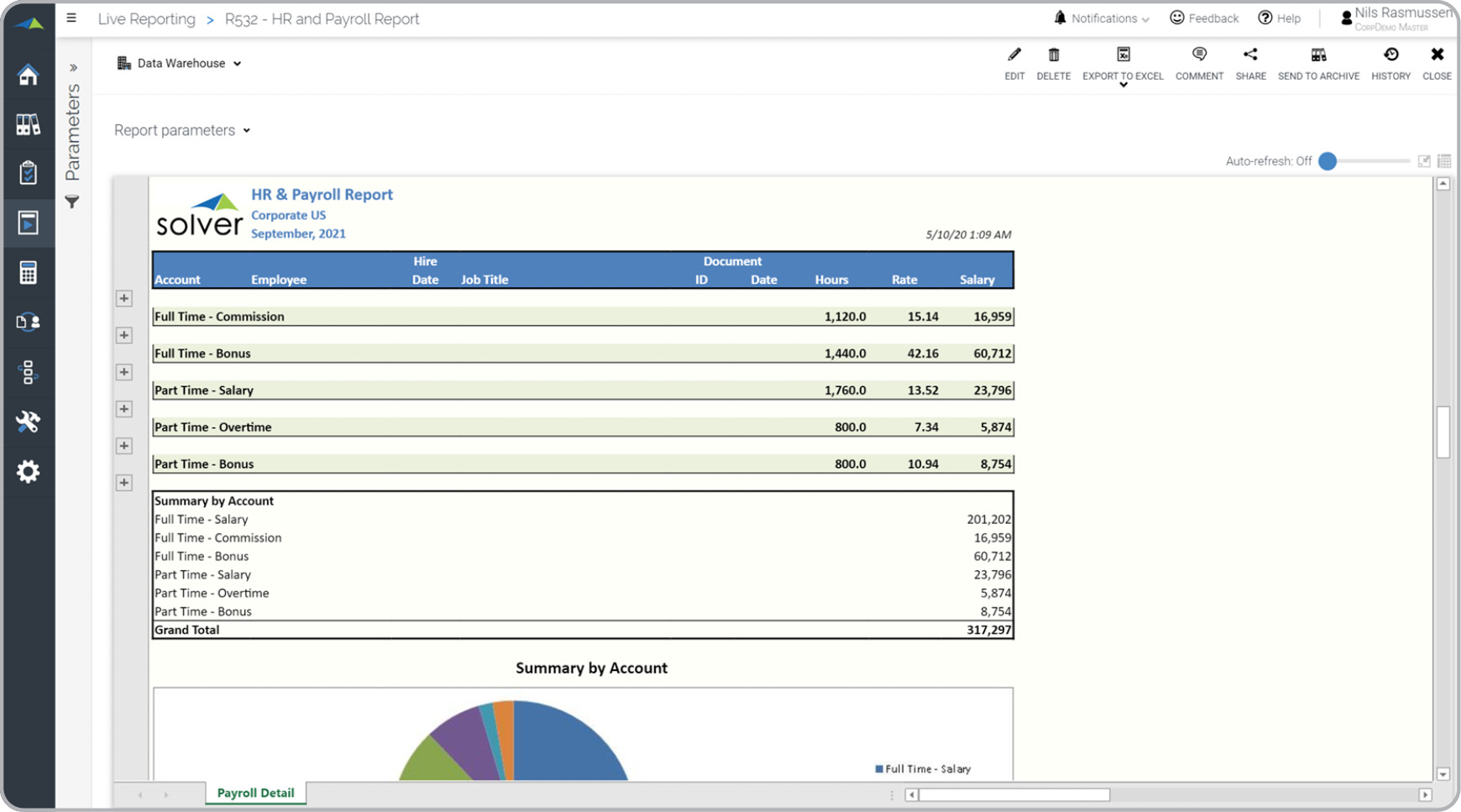Workforce Compensation Report with Payroll Analysis
What is
a
Workforce Compensation Report with Payroll Analysis
? HR and Payroll reports are considered workforce compensation analysis tools and are often used by accountants and payroll managers to review employee hours, rates and salary expenses. Some of the key functionality in this type of report is that it is parameter driven and provides both transaction detail and summary payroll related information. The columns shows General Ledger (GL) account, employee name, hire date, job title, rates, salary and other information. The rows are grouped into major expense categories such as commissions, bonuses, salary, overtime and bonus. Each row can be expanded to see individual employees (not visible in the example below) and their detailed information. At the bottom of the report, is a summary by GL account as well as a chart to visualize the same information. You find an example of this type of report below.
Purpose of
Compensation analysis reports Companies and organizations use compensation analysis reports to analyze payroll expenses using a professional and easy to read web-based report format. When used as part of good business practices in a Financial Planning & Analysis (FP&A) and Payroll department, a company can improve its payroll expense analysis as well as reduce the chances that managers make staffing decisions and budgets without a detailed understanding of actual employee compensation costs.
Compensation analysis report
Example Here is an example of a Workforce Compensation Report with Payroll Analysis. [caption id="" align="alignnone" width="1740"]
 Workforce Compensation Report with Payroll Analysis Example[/caption] You can find hundreds of additional examples
here
Who Uses This Type of
Report
? The typical users of this type of report are: CFOs, accountants, payroll managers, budget managers, human resource (HR) Managers.
Other
Report
s Often Used in Conjunction with
Compensation analysis reports Progressive Financial Planning & Analysis (FP&A) and Payroll Departments sometimes use several different Compensation analysis reports, along with HR reports, payroll budgets, staffing forecasts and other management and control tools.
Where Does the Data for Analysis Originate From? The Actual (historical transactions) data typically comes from Payroll and enterprise resource planning (ERP) systems like: Microsoft Dynamics 365 (D365) Finance, Microsoft Dynamics 365 Business Central (D365 BC), Microsoft Dynamics AX, Microsoft Dynamics NAV, Microsoft Dynamics GP, Microsoft Dynamics SL, Sage Intacct, Sage 100, Sage 300, Sage 500, Sage X3, SAP Business One, SAP ByDesign, Acumatica, Netsuite, Workday, ADP, Ceridian, Payroll Now and others. In analyses where budgets or forecasts are used, the planning data most often originates from in-house Excel spreadsheet models or from professional corporate performance management (CPM/EPM) solutions.
What Tools are Typically used for Reporting, Planning and Dashboards? Examples of business software used with the data and ERPs mentioned above are:
Workforce Compensation Report with Payroll Analysis Example[/caption] You can find hundreds of additional examples
here
Who Uses This Type of
Report
? The typical users of this type of report are: CFOs, accountants, payroll managers, budget managers, human resource (HR) Managers.
Other
Report
s Often Used in Conjunction with
Compensation analysis reports Progressive Financial Planning & Analysis (FP&A) and Payroll Departments sometimes use several different Compensation analysis reports, along with HR reports, payroll budgets, staffing forecasts and other management and control tools.
Where Does the Data for Analysis Originate From? The Actual (historical transactions) data typically comes from Payroll and enterprise resource planning (ERP) systems like: Microsoft Dynamics 365 (D365) Finance, Microsoft Dynamics 365 Business Central (D365 BC), Microsoft Dynamics AX, Microsoft Dynamics NAV, Microsoft Dynamics GP, Microsoft Dynamics SL, Sage Intacct, Sage 100, Sage 300, Sage 500, Sage X3, SAP Business One, SAP ByDesign, Acumatica, Netsuite, Workday, ADP, Ceridian, Payroll Now and others. In analyses where budgets or forecasts are used, the planning data most often originates from in-house Excel spreadsheet models or from professional corporate performance management (CPM/EPM) solutions.
What Tools are Typically used for Reporting, Planning and Dashboards? Examples of business software used with the data and ERPs mentioned above are:
- Native ERP report writers and query tools
- Spreadsheets (for example Microsoft Excel)
- Corporate Performance Management (CPM) tools (for example Solver)
- Dashboards (for example Microsoft Power BI and Tableau)
Corporate Performance Management (CPM) Cloud Solutions and More Examples
November 19, 2020
TAGS:
Reporting,
Solver,
report writer,
Microsoft,
Payroll,
template,
practice,
Acumatica,
Netsuite,
Finance,
GP,
Business Central,
hr,
excel,
ax,
forecast,
Budget,
forecasting,
Employee,
analysis,
budgeting,
FTE,
Cloud,
Software,
Tableau,
SAP,
compensation,
example,
best,
Sage,
BC,
D365,
NAV,
Intacct,
salary,
CPM,
report,
SL,
Management,
dynamics,
Power BI,
ADP,
Ceridian,
human,
Payroll Now

